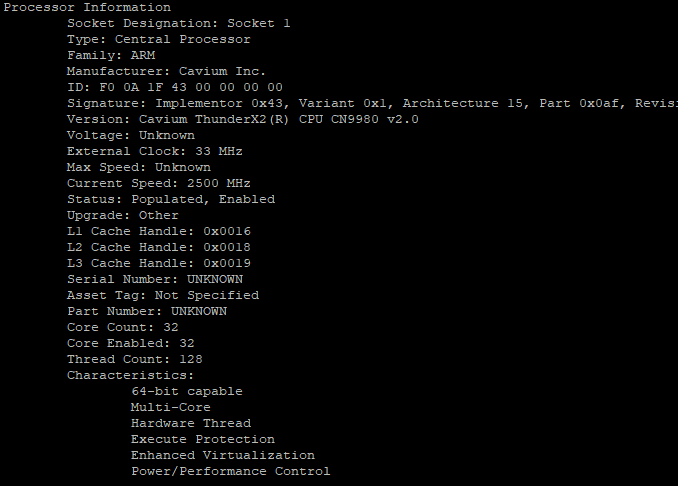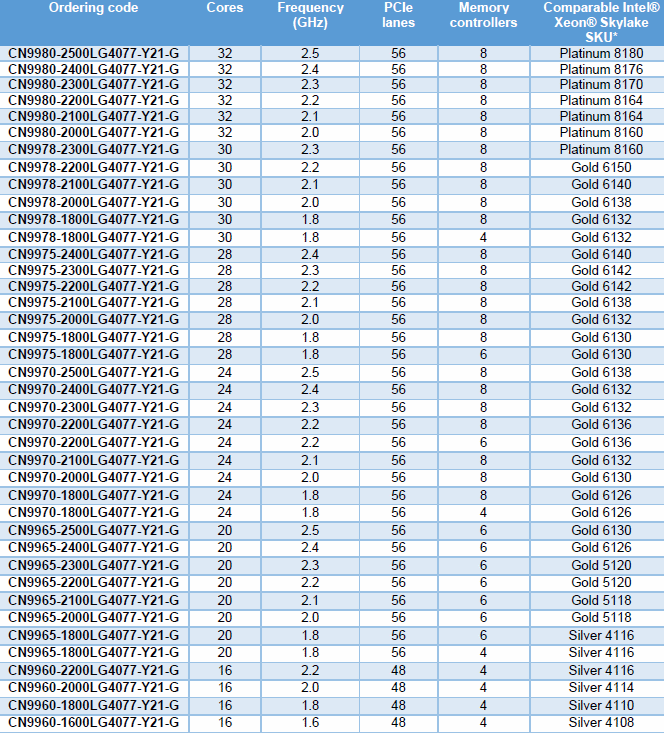Assessing Cavium's ThunderX2: The Arm Server Dream Realized At Last
by Johan De Gelas on May 23, 2018 9:00 AM EST- Posted in
- CPUs
- Arm
- Enterprise
- SoCs
- Enterprise CPUs
- ARMv8
- Cavium
- ThunderX
- ThunderX2
The ThunderX2 SKUs: 16 to 32 Cores
The SKU inside our test system was the ThunderX2 CN9980 2.2. This is the top SKU that is available right now, offering 32 cores at 2.2 GHz, which are able to further boost to 2.5 GHz.
According to Cavium's plans, many more SKUs will be available in the coming months. Cavium claims that a CN9980 at 2.5 GHz will be available soon, which would be capable of boosting to 3 GHz.
Cavium has listed all of their planned SKUs together alongside the comparable Intel SKU. By Cavium's definition, a comparable Intel SKU is a chip that achieves the same SPECInRate (2017) under gcc as Cavium's SKU.
As you can see, Cavium considers our CN9880 2.2 to be comparable to the much more expensive 8164. For our testing we will compare it to the 8176, as that was the Intel SKU available to us. Not that it should matter much: the 8176 only has a 3% higher clockspeed and 2 additional cores (+7%) over the 8164. Note however that if Cavium's ThunderX2 can really compete with these Intel SKUs, they are offering the same performance at one third of the cost of the Intel SKUs.












97 Comments
View All Comments
DrizztVD - Wednesday, May 23, 2018 - link
It amazes me how the one big advantage ARM could have is the power efficiency, yet no power efficiency numbers in this review? It's like someone just isn't thinking about what can best showcase the ARM advantage and testing it.boeush - Thursday, May 24, 2018 - link
You must have missed this bit:"So as is typically the case for early test systems, we are not able to do any accurate power comparisons.
In fact, Cavium claims that the actual systems from HP, Gigabyte and others will be far more power efficient."
This was an early (and apparently quite buggy, especially from the power management standpoint) test system. It's not representative of final production systems in these respects, so doing what you request on it would only put a very crude lower bound on efficiency, at best.
That's why the final section of the write-up has a title ending in ": so far"... (obviously, there will be more to come if/when real production-quality systems are available for benchmarking/analysis.)
ZolaIII - Thursday, May 24, 2018 - link
It's broken currently on the MB. If you want to see real power/performance metrics for a SoC made on comparable lithography to the lintels 14 nm (aka TSMC 10nm) & with optimised software read this:https://blog.cloudflare.com/neon-is-the-new-black/
drwho9437 - Wednesday, May 23, 2018 - link
Thanks Johan, I've been reading since Ace's. I can't believe it has been more almost 20 years. Even though I don't work in this market I still read everything you write.JohanAnandtech - Friday, May 25, 2018 - link
It was indeed almost 20 years ago that I published my first article about the K6-2 vs Pentium MMX. And Anand's star was about to rise with the launch of the K6-3 :-).Spatz - Wednesday, May 30, 2018 - link
Wow. Aces hardware... that used to be my go to for hardware reviews back in the day. I can’t believe your still at it! This article was great. Keep up the good work.beginner99 - Thursday, May 24, 2018 - link
So it for sure is an option. however I d not get the focus on price. The CPU cost is a small fraction of the total server cost and a tiny if infrastructure cost (network, HVAC,...) is included. Add to that the software and data running on that server and if your CPU is 5% faster at same power it costing $5000 more might be totally worth it.Apple Worshipper - Thursday, May 24, 2018 - link
Errmm... does ARM feature SMT now?Ryan Smith - Thursday, May 24, 2018 - link
Not in Arm's own cores. But in Cavium's ThunderX2, yes.sgeocla - Thursday, May 24, 2018 - link
What's up with EPYC comparison missing in almost all benchmarks?EPYC has been out for a while and the only benchmarks are from almost a year ago?